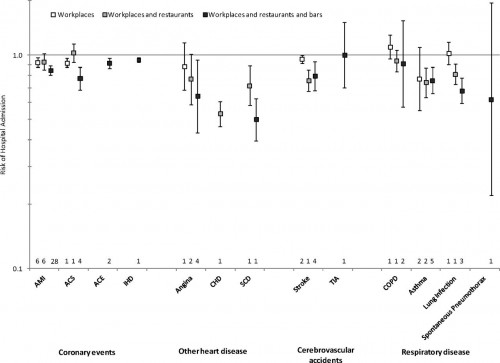It’s incredibly hard to study the effect of legislation. So many factors come into play. That doesn’t mean we shouldn’t try. I just saw a study entitled, “Association Between Smoke-Free Legislation and Hospitalizations for Cardiac, Cerebrovascular, and Respiratory Diseases”:
Background—Secondhand smoke causes cardiovascular and respiratory disease. Smoke-free legislation is associated with a lower risk of hospitalization and death from these diseases.
Methods and Results—Random-effects meta-analysis was conducted by law comprehensiveness to determine the relationship between smoke-free legislation and hospital admission or death from cardiac, cerebrovascular, and respiratory diseases. Studies were identified by using a systematic search for studies published before November 30, 2011 with the use of the Science Citation Index, Google Scholar, PubMed, and Embase and references in identified articles. Change in hospital admissions (or deaths) in the presence of a smoke-free law, duration of follow-up, and law comprehensiveness (workplaces only; workplaces and restaurants; or workplaces, restaurants, and bars) were recorded. Forty-five studies of 33 smoke-free laws with median follow-up of 24 months (range, 2–57 months) were included. Comprehensive smoke-free legislation was associated with significantly lower rates of hospital admissions (or deaths) for all 4 diagnostic groups: coronary events (relative risk, 0.848; 95% confidence interval 0.816–0.881), other heart disease (relative risk, 0.610; 95% confidence interval, 0.440–0.847), cerebrovascular accidents (relative risk, 0.840; 95% confidence interval, 0.753–0.936), and respiratory disease (relative risk, 0.760; 95% confidence interval, 0.682–0.846). The difference in risk following comprehensive smoke-free laws does not change with longer follow-up. More comprehensive laws were associated with larger changes in risk.
This was a meta-analysis of studies looking at hospital admissions in the presence of a smoke-free law. The work included 45 studies of the effects of 33 laws with a median follow-up of 2 years. Here’s a nice figure from the study:
What you are looking is the relative risk of hospital admissions for a number of conditions (AMI =acute myocardial infarction, ACS = acute coronary syndrome, ACE = acute coronary event, IHD = ischemic heart disease, CHD = coronary heart disease, TIA = transient ischemic attack, and COPD = chronic obstructive pulmonary disease) after a smoke-free law was put in place, compared with before. The square is the result of a study, eith the lines representing the 95% confidence interval. A dot below the horizontal line of 1.0, that means the law was associated with a reduction in the risk of hospital admission. If the dot is above the 1.0 line, then the law was associated with an increase in admission. If the 95% confidence interval does not cross the 1.0 line, then the result is statistically significant.
As you can see, almost every dot is below the line. Moreover, many of the dots have confidence intervals that show the results are significant. When grouped, these laws were associated with significant reductions in admissions for coronary events, other heart disease, cerebrovascular accidents, and respiratory disease.
Icing on the cake: laws that were more comprehensive were associated with larger reductions in risk of hospitalization.
No research is perfect. But this is pretty good. Additionally, all the results tend to point in the same direction. It looks like smoke-free laws work.


